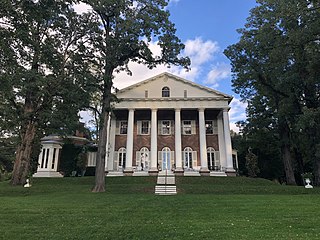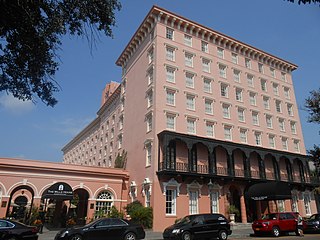
The Battery is a landmark defensive seawall and promenade in Charleston, South Carolina. Named for a pre-Civil War coastal defense artillery battery originally built by the British at the site, it stretches along the lower shores of the Charleston peninsula, bordered by the Ashley and Cooper Rivers, which meet here to form Charleston Harbor.
Richard Hampton Jenrette was an American businessman who co-founded the investment bank Donaldson, Lufkin & Jenrette (DLJ).
Rainbow Row is the name for a series of thirteen colorful historic houses in Charleston, South Carolina. The houses are located north of Tradd St. and south of Elliott St. on East Bay Street, that is, 79 to 107 East Bay Street. The name Rainbow Row was coined after the pastel colors they were painted as they were restored in the 1930s and 1940s. It is a popular tourist attraction and is one of the most photographed parts of Charleston.

Edgewater is an architecturally significant, early 19th-century house located near the hamlet of Barrytown in Dutchess County, New York, United States. Built about 1824, the house is a contributing property to the Hudson River Historic District. Edgewater's principal architectural feature is a monumental colonnade of six Doric columns, looking out across a lawn to the Hudson River. Writing in 1942, the historians Eberlein and Hubbard described Edgewater as an exemplar of "the combined dignity and subtle grace that marked the houses of the Federal Era."

The 1980 United States House of Representatives elections in South Carolina were held on November 4, 1980, to select six Representatives for two-year terms from the state of South Carolina. The primary elections for the Democrats and the Republicans were held on June 10 and the runoff elections were held two weeks later on June 24. Three incumbents were re-elected, but John Jenrette of the 6th congressional district was defeated in his bid for re-election and the open seat in the 1st congressional district was taken by the Republicans from the Democrats. The composition of the state delegation after the elections was four Republicans and two Democrats.

Millford Plantation is a historic farmstead and plantation house located on SC 261 west of Pinewood, South Carolina. It was sometimes called Manning's Folly, because of its remote location in the High Hills of Santee section of the state and its elaborate details. Designated as a National Historic Landmark, it is regarded as one of the finest examples of Greek Revival residential architecture in the United States. The house has been restored and preserved along with many of its original Duncan Phyfe furnishings.

The U.S. Custom House or U.S. Customhouse is the custom house in Charleston, South Carolina. Construction began in 1852, but was interrupted in 1859 due to costs and the possibility of South Carolina's secession from the Union. After the Civil War, construction was restarted in 1870 and completed in 1879. The building was placed on the National Register of Historic Places on October 9, 1974. It is also a contributing property of the Charleston Historic District.

Magnolia Cemetery is a historic rural cemetery in Charleston, South Carolina. The first board for the cemetery was assembled in 1849 with Edward C. Jones as the architect. It was dedicated in 1850; Charles Fraser delivered the dedication address. It was listed on the National Register of Historic Places as a Historic District in 1978.

The U.S. Post Office and Courthouse is a historic post office and courthouse located at Charleston in Charleston County, South Carolina. The building and its annexes serve the federal court for the Charleston Division of the United States District Court for the District of South Carolina. The building was listed on the National Register of Historic Places in 1974.

The George F. Baker Jr. Houses are a complex of three residential buildings at 67, 69, and 75 East 93rd Street on the Upper East Side of Manhattan in New York City. They were completed in 1918–1931 to the designs of the architecture firm Delano & Aldrich. The oldest of the group is the Francis F. Palmer House at 75 East 93rd Street; the other two houses were erected by a later owner, George Baker Jr. The three buildings are New York City designated landmarks, and the entire ensemble was added as a group to the National Register of Historic Places in 1982.

Edward Culliatt Jones was an American architect from Charleston, South Carolina. A number of his works are listed on the U.S. National Register of Historic Places, and two are further designated as U.S. National Historic Landmarks. His works include the following :

John Henry Devereux, also called John Delorey before 1860, was an American architect and builder best known for his designs in Charleston, South Carolina. According to the National Park Service, he was the "most prolific architect of the post-Civil War era" in the Charleston area. His works are listed on the U.S. National Register of Historic Places. His Charleston Post Office and Courthouse has been designated as a U.S. National Historic Landmark.

Brookland Plantation is a large plantation along Shingle Creek on Edisto Island, South Carolina.

The James Sparrow House is an excellent example of a Charleston single house in the late Federal style. It is named for a Charleston butcher who acquired the property at 65 Cannon St. in 1797. Several other butchers owned and lived in the house by 1825 when Christian David Happoldt bought the house. It remained in his family until 1907. It is a two and one-half story stuccoed brick house, raised on a basement of the same material. The masonry has an embellished by a dog-tooth cornice, with full return, repeated in the rake of the gable end. Quoins of stuccoed brick articulate the corners and a stringcourse of the same material delineates the floor levels. Two interior chimneys, with Gothic arched hoods, on the east side of the house were reconstructed after the earthquake of 1886. The house was listed in the National Register January 30, 1998.

The James Simmons House is a late 18th-century house at 37 Meeting Street, Charleston, South Carolina which was, at one time, the most expensive house sold in Charleston. It was likely built for James Simmons, a lawyer. By 1782, it was home to Robert Gibbes, a planter. Louisa Cheves, a prominent antebellum writer, was born at the house on December 3, 1810. In 1840, Otis Mills, the owner of the Mills House Hotel, bought the house for $9,000. In October 1862, during the Civil War, the house was loaned to Gen. Pierre Beauregard, who used the house as his headquarters until August 1863. In 1876, Michael P. O'Connor, later a member of Congress, bought the house.

The Charleston Renaissance is a period between World Wars I and II in which the city of Charleston, South Carolina, experienced a boom in the arts as artists, writers, architects, and historical preservationists came together to improve and represent their city. The Charleston Renaissance was related to the larger interwar artistic movement known as the Southern Renaissance and is credited with helping to spur the city's tourist industry.
Albert Simons, had a sixty-year career as an architect and preservationist in Charleston, South Carolina, where he is known for his preservation work and architectural design. He played a key role in the Charleston Renaissance. Simons helped to create many nationally prominent preservation functions such as the zoning ordinance for the historic district, the first such ordinance in America, with municipal austerity, and the first Board of Architectural Review. As a professor at the College of Charleston for over 20 years, he started the School of the Arts whose building is named after him and is honored yearly through the Simons Medal of Excellence.

The Mills House Charleston, Curio Collection by Hilton is a historic hotel in Charleston, South Carolina, United States. It opened in 1970, but its facade is based on the original historic hotel that sat on the site from 1853 to 1968.
Beatrice St. Julien Ravenel was an American writer known for her books on the architecture and history of Charleston, South Carolina.
Charles Dufort "Pug" Ravenel was an American politician and member of the Democratic Party from South Carolina who won the 1974 Democratic gubernatorial primary. Ravenel was the favorite to win the general election until the South Carolina Supreme Court ruled his candidacy invalid on the grounds that he did not meet the state's residency requirements. The eventual winner of the election was James B. Edwards, the state's first Republican governor in decades.






















